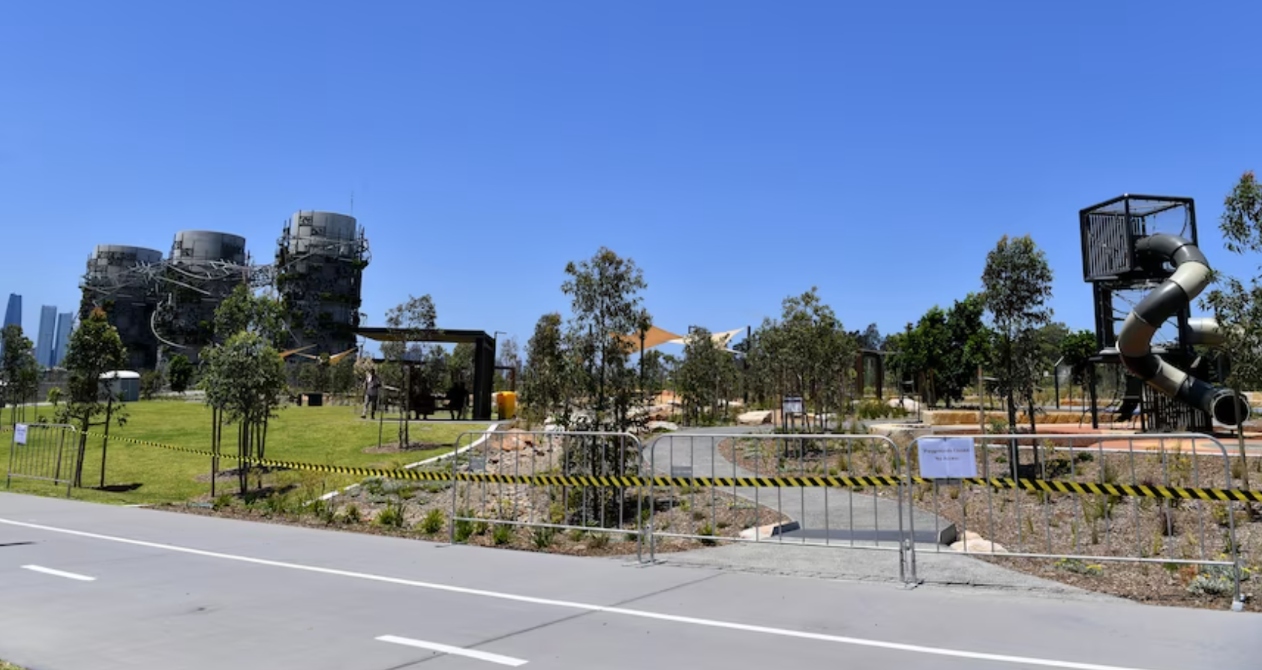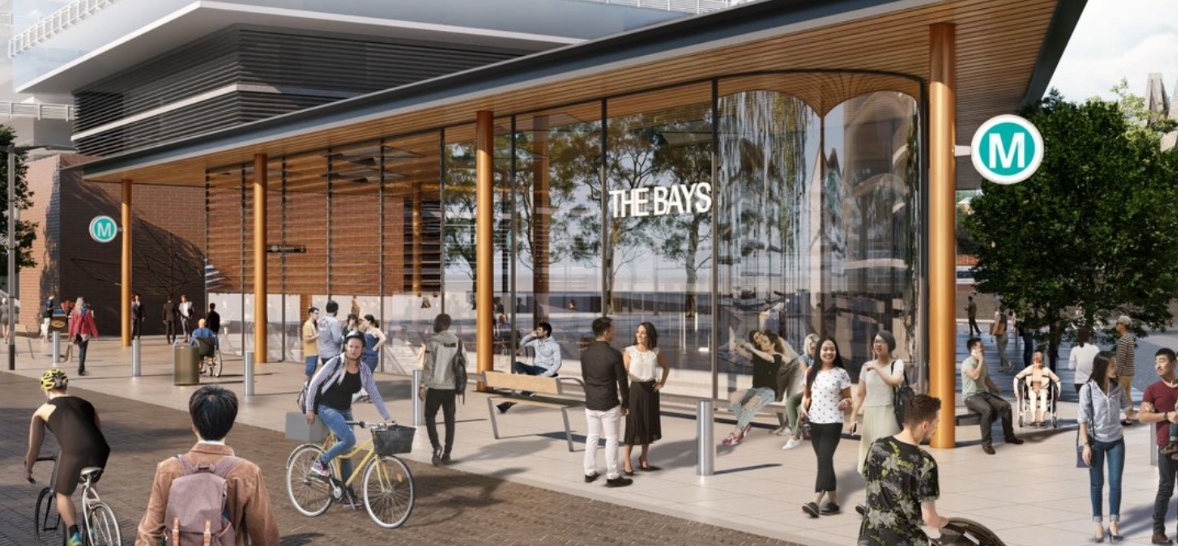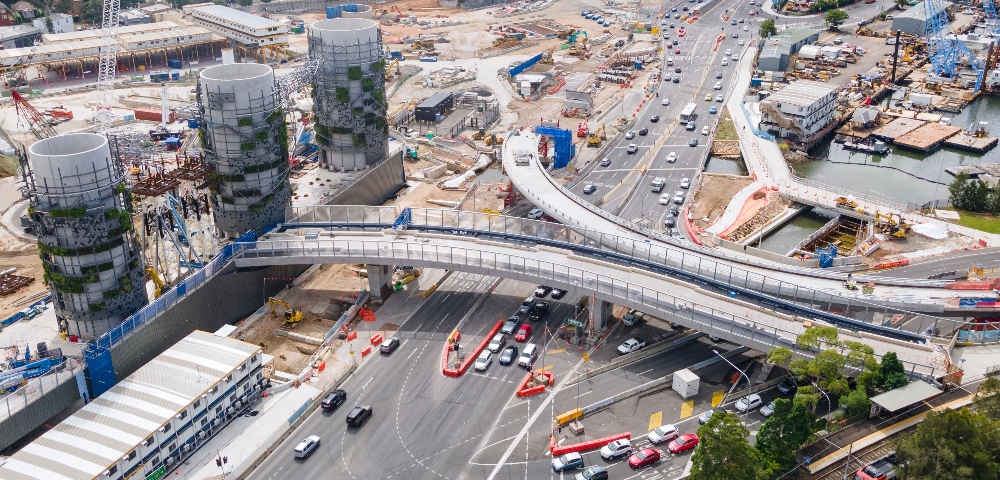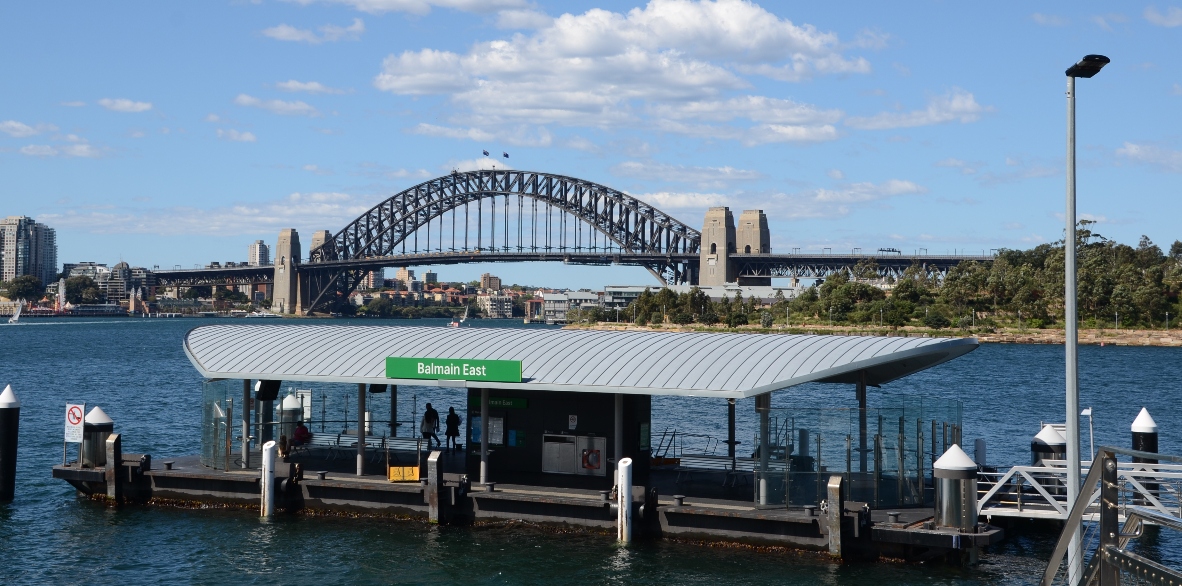
Transport for NSW kept Inner West Council in the dark about St Peters contamination

Image: Transport for NSW failed to inform council about public safety concerns for a proposed park in St Peters. Photo: Peter Boyle.
By WENDY BACON
Transport for NSW failed to inform Inner West Council (IWC) about public safety concerns for land in St Peters that it wanted the Council to manage as a park.
A City Hub investigation has found that the NSW Environmental Protection Authority’s concerns about hazard risks at the site led it to require fresh reports and monitoring of the land that is part of the WestConnex Interchange. These requirements and concerns were never passed onto Council by Transport for NSW.
Although a spokesperson for Transport for NSW has now told City Hub that the NSW government proposes to take responsibility for the park, IWC Independent councillor Pauline Lockie remains concerned about the lack of information about the environmental state of the land and whether it is still a public health concern for those who live and work in the area.
The proposed park or ‘look-out’ is a mound or small hill of decomposing toxic waste capped with soil. It’s near a busy intersection beside an unfiltered ventilation stack at the WestConnex M8 Interchange, a massive expanse of tolled roads and concrete bridges that stretches across an old landfill site. What can’t be seen but is revealed by City Hub’s search of the most recent gas monitoring records is that some sections of the old landfill have still been releasing explosive levels of methane.
The old landfill was operated by Ian Malouf’s Dial-A-Dump until it was compulsorily acquired by the NSW Roads and Maritime Services in 2014 for the Westconnex M8, a 7-kilometre tunnel linking Kingsgrove and St Peters. The M8 opened in mid-2020.
The hill was supposed to be part of six hectares of open space that the NSW government pushed as compensation for the St Peters community that lost scores of homes and hundreds of major trees to WestConnex.
When you think of a park, you may visualise an oasis of tree-covered open space which is how the WestConnex PR videos presented it back in 2015. One video featured giant trees dwarfing concrete bridges and another was populated with pedestrians gliding along paths in open green spaces that merged seamlessly with the popular regional Sydney Park.
St Peters space labelled ‘World’s Worst Park’
The WestConnex Action Group (WAG), supported by thousands of residents opposed to the tollway, were sceptical of the videos and dubbed it the ‘world’s worst park. WAG spokesperson Pauline Lockie, who lost her home to WestConnex, is now an Inner West councillor.

Despite objections by thousands of residents and local Councils, the project was approved. The St Peters community survived three years of screeching noise in the night, poor management of asbestos and contaminated waste tracked onto nearby roads and dust storms. But worst of all was the hydrogen sulphide or ‘rotten egg gas’ odours that CPB Contractors (previously called Leightons) were unable to control as they dug up the toxic waste that had been left behind by Dial-a-Dump Pty Ltd, which was not required to clean up the site. By then Malouf had started a new Dial-A-Dump landfill in an old quarry at Eastern Creek in far western Sydney.
Residents lodged hundreds of complaints about the odours which made their lives miserable for months. The EPA issued directions to CPB Contractors to clean up the site but the odours continued. WAG called for the EPA to use its powers to stop work on the site. Only then did it discover that the NSW government had quietly passed a law that removed the EPA’s power to stop work on sites that the Minister for Planning deemed to be ‘critical infrastructure’. With nothing more than a signature, WestConnex had become one of those sites.
The odours eventually subsided but questions remained. Dial-A-Dump was classed as a non-putrescible landfill. Putrescible waste is solid waste that contains organic matter capable of being decomposed by microorganisms that cause offensive odours. It also produces a liquid called leachate which contains contaminants. Why was a landfill that was not supposed to accept organic waste producing such terrible odours? The EPA did not provide the community with any information that could explain this.
Two years later, the EPA took CPB Contractors to the NSW Land and Environment Court. The company pleaded guilty to ‘causing serious harm’ to residents, school children, workers and EPA staff by failing to control toxic odours from untreated leachate or contaminated water pooling at the WestConnex St Peters Interchange site. The harm included asthma attacks, chest pain and severe nausea. CPB acknowledged that it failed to hire a suitable expert to supervise construction at the old landfill site and that had it done so, serious harm could have been prevented. CPB Contractors were ordered to pay $445,000 in fines and costs. Not too long afterwards, CPB was awarded a joint contract with John Holland to build the massive WestConnex Rozelle Interchange. It has also been granted a contract to begin the Western Harbour Tunnel, which also has residents and councils concerned about contamination.
When the toll road was ready to open in mid-2020, CPB Contractors, like Ian Malouf before them, were allowed to leave the site without remediating it. The EPA licence, which sets out conditions to control pollution on the site, reverted to Transport for NSW (previously RMS).
Seven years later, residents’ worst fears about the park were realised. The PR vision translated into a depressing spectacle along which you can travel on a narrow cycling track that comes to an abrupt end near the fenced-off mound of decomposing waste.
Explosive levels of methane
Sub-surface monitoring continues to show explosive levels of methane at some gas wells. But despite these high levels, Transport for NSW appeared ready to open the land, including the mound, to the public in mid-2020. A park bench and some corporate art fixtures were installed on top of the hill.
Transport for NSW began negotiations with the Inner West Council to take over the management of the park. Council was reluctant. IWC Director of Infrastructure Cathy Edwards-Davis told Council, “We were only asked to take over this land very shortly prior to the completion of the M8 tunnel and as a result, Council staff have had no input into the design of this land”.
When heavy rains arrived in early 2021, Ms Lockie and other residents noticed that there were landslides and vegetation that was struggling to take hold on the mound was dying. She turned to independent scientist Charlie Pierce who is also the Research Director of the Community Environment Monitoring group that assists communities battling pollution issues. They had met during the Westconnex M8 Environmental Impact Approval process when Pierce submitted a detailed critique of the inadequate landfill closure plans. He noted the high ammonia levels that should not have been present in a landfill that was only licensed to accept non-putrescible waste. Such independent advice in the public interest is rare as most consultants only do reports for clients who can afford high fees.

Unlike residents, Pierce knew where to find gas monitoring results on the Transport for NSW website. These are ‘public’ in the sense that they are published on the Department’s website but are difficult for the average citizen to find. He discovered that monitoring data revealed that several gas monitoring wells within the toxic parkland had recorded gas methane above the lower explosive level of five per cent. Additionally, surface monitoring methane concentrations above 1 per cent are supposed to trigger an investigation. Some monitoring wells showed levels more than 15 times above explosive level. This raises safety concerns because methane above this limit can accumulate and become an explosive hazard.
Council rejects park and calls for alternative public space
Lockie moved a motion calling for an independent investigation that was unanimously passed by IWC. Greens Rochelle Porteous, then IWC mayor, wrote to the then Minister Andrew Constance in September last year calling for an investigation and arguing that the the “NSW government should commit to delivering and managing the parkland it had promised the community as compensation for WestConnex rather than handing our community a potentially contaminated liability”. She called for “an alternative compensatory high quality and uncontaminated open space”.
Constance had not responded by the time he resigned from the NSW government in December. He is now standing in the federal election for the seat of Gilmore on the NSW South Coast. David Elliott is now the Minister for Transport. The IWC never received a response.
Transport for NSW also failed to tell the Council that at the time it was trying to persuade IWC to take on the park, the NSW Environment Protection Authority had required a lot more investigation and work to be done before it could guarantee that open space around the toll road was not a public health hazard.
Monitoring gaps and high contamination levels in St Peters
EPA requires organisations granted pollution licence to file annual reports. Unfortunately, the reports are not public but a summary of non-compliance issues is published on the EPA website. From the years 2020 to 2021, the EPA summary reveals that no data had been collected at 16 monitoring points. On several occasions, groundwater monitoring results also showed high levels of ammonia and elevated levels of copper and zinc. Wrong standards were applied at another monitoring point. Neither Council nor the public was informed of these licence breaches. No penalties were imposed.
In 2020, the EPA found that a risk assessment that had been conducted by a private consultant was not sufficient and required Transport for NSW to appoint an independent auditor to conduct a fresh new hazard assessment. It then found that a draft version of the auditor’s report needed to be revised because he had not been able to get the information required. Transport for NSW applied for an extension to complete the assessment in December 2021 and a further extension in February 2022. Monitoring documents reveal that consultants cannot access parts of the WestConnex site where previously very high methane levels have been recorded. This includes the entrance to the M8 tunnel and a building near the mound.
But these are not the only problems. What the public and the Council have also not been told is that on February 14th this year, the EPA received an application to vary the pollution licence so that remediation works could be carried out to repair a section of the toll road originally constructed by CPB Contractors. This work, costing millions of dollars, will take about 18 months.
Lockie ‘appalled’ that Council kept in the dark
When City Hub told her about these reports and inadequacies in the information, councillor Lockie said, “I’m shocked to know now that Transport for NSW knew the site was in need of serious remediation even as they were pushing Council to take responsibility for managing it. I had no idea that the NSW Environmental Protection Authority had already ordered a thorough risk assessment, which was clearly going to take a lot of time and provide evidence about the complex steps that will need to be taken to remediate the site. I’m appalled we were kept in the dark on a matter of public health.”
It now seems that Transport for NSW has accepted that the Inner West Council will not take over the land. In April, a Transport for NSW spokesperson told City Hub that “Transport for NSW is developing the elevated area at the St Peters intersection as public open space, with a circular path and open area at the summit featuring views of the CBD, airport and surrounding suburbs and the slopes planted with native vegetation. Transport is responsible for the maintenance and operation of the park”.
However for Lockie that is not the end of the matter. She insists that Council must see all the hazard assessments and other reports on the site: “We need to be sure that the contaminated site does not raise health issues for our community. We have a potentially contaminated site right next to where thousands of us live, work and play.”
She also says that the WestConnex interchange will never be ‘fit for purpose’ as a park. For this reason, she argues that Transport for NSW needs to work with Council to identify an alternative site to provide genuine open space and parkland to compensate our community for the impact WestConnex has had, and continues to have, on the surrounding areas.
Environmental scientist Charlie Pierce also still has concerns. “Looking at the chemistry reported in leachate monitoring results, it is evident that the landfill is still in the active methanogenic stage with decades before stabilisation.”
Last year, Pierce contacted the Director of Environment and Sustainability at Transport for NSW to find out what engineering solutions had been put in place to manage the ongoing environmental emissions at the landfill. They referred him to a Golders Associates Landfill Closure Management Plan (LCMP), which identified various options depending on conditions. Pierce raised more queries but received no further information. He told City Hub, “I would expect that the active landfill gas extraction system identified in the [Golders] plan would have been installed. However, looking over the site from the boundaries, I was not able to locate the flare which is a critical component of the proposed active extraction system.” He also points out that the EPA licence requires monthly monitoring of landfill methane surface gas emissions, but these reports have not been published by Transport for NSW as required by the EPA.
Pierce says that “the best way for the community to understand what is happening at landfill sites exhibiting poor environmental performance is for making the reports prepared by NSW Environmental Auditors publicly available. Then groups like Community Environmental Monitoring can look at the professional assessments and inform the public in easy to understand language”. Even the monitoring results that are required to be published online are “hard to find, and for the layperson, impossible to understand,” says Pierce.
Questions remain
Like many local stories, this one has broader implications. It symbolises the environmental degradation that occurs in NSW through destructive planning processes in which corporate players are allowed to drive the agenda and are rarely held accountable. Individual EPA officers often work hard to fix problems as they arise, but are forced to adjust requirements when companies breach conditions or fail to meet deadlines. The EPA is slow to make decisions to prosecute and when they do, penalties are trifling when compared to the overall profits of major companies.
This case will resonate with communities across Sydney dealing with pollution, including those in suburbs near Eastern Creek in Sydney’s far West where residents have been repeatedly overwhelmed by odours from Macquarie-owned Bingo Industries’ Waste Facility. This is the landfill that Malouf developed after leaving St Peters. It also has a legacy of environmental breaches. In 2018, Malouf sold Dial-A-Dump to Bingo Industries for $500 million and a continuing share in the company. In 2021, Bingo was sold to Macquarie Group for $2.3 billion.
After more than a year and hundreds of complaints, the NSW EPA initiated a criminal prosecution against Bingo Industries last week. The odours however continue.
This story also leaves questions unanswered. Why was Malouf allowed to leave St Peters without cleaning up the site? Did the NSW government’s desire to get the WestConnex underway mean that the closure of the toxic site was rushed, leaving a legacy of environmental issues that could burden the public purse for decades.
Transport for NSW has failed to follow conditions in its licence and meet EPA requirements and deadlines? Does EPA have sufficient powers to regulate major infrastructure sites? Why does the WestConnex site need remediation, less than two years after it opened? Who is paying for this work? Why did Transport for NSW keep IWC in the dark? What would have been the consequences for the public and Councill if Councillor Lockie had not blown the whistle? Does IWC itself have sufficient resources to keep on top of environmental issues – do hard working staff have enough time to track contamination at the landfill?
If you would like to know more about how residents in suburbs around Eastern Creek have also been failed by NSW’s environmental and planning system, you can read about it on my blog where there are 8 stories on this topic.









